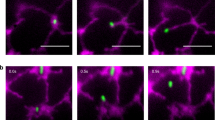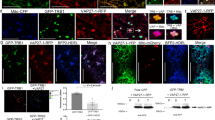Abstract
URF13 is the product of a mitochondrial-encoded gene (T-urfl3) found only in maize plants containing the Texas male-sterile cytoplasm (cms-T), and it is thought to be responsible for both cytoplasmic male sterility and the susceptibility ofcms-T maize to the fungal pathogensBipolaris maydis race T andPhyllosticta maydis. Mitochondria isolated fromcms-T maize are uniquely sensitive to pathotoxins (T-toxin) produced by these fungi and to methomyl (a commercial insecticide). URF13 acts as a receptor that specifically binds T-toxin to produce hydrophilic pores in the inner mitochondrial membrane. When expressed inEscherichia coli cells, URF13 also forms hydrophilic pores in the plasma membrane if exposed to T-toxin or methomyl. Topological studies established that URF13 contains three membrane-spanning α-helices, two of which are amphipathic and can contribute to pore formation. Chemical crosslinking of URF13 was used to demonstrate the existence of URF13 oligomers incms-T mitochondria andE. coli cells. The ability of the carboxylate-specific reagent,N,N∼-dicyclohexycarbodiimide, to cross-link URF13 was used in conjunction with site-directed mutagenesis to establish that the URF13 tetramer has a central core consisting of a four-α-helical bundle which undergoes a conformational change after interaction with T-toxin or methomyl. Overall, the experimental evidence indicates that URF13 functions as a ligand-gated, pore-forming T-toxin receptor incms-T mitochondria.
Similar content being viewed by others
References
Aranda, G., Durlin, P., and Gauvrit, C. (1987).Phytochemistry 26, 1909–1913.
Bednarski, M. A., Izawa, S., and Scheffer, R. P. (1977).Plant Physiol. 59, 540–545.
Bervillé, A., Ghazi, A., Charbonnier, M., and Bonavent, J.-F. (1984).Plant Physiol. 76, 508–517.
Bouthyette, P.-Y., Spitsberg, V., and Gregory, P. (1985).J. Exp. Bot. 36, 511–528.
Braun, C. J., Siedow, J. N., Williams, M. E., and Levings, C. S., III (1989).Proc. Natl. Acad. Sci. USA 86, 4435–4439.
Braun, C. J., Siedow, J. N., and Levings, C. S., III (1990).Plant Cell 2, 153–161.
Brettell, R. I. S., Goddard, B. V. D., and Ingram, D. S. (1979).Maydica 24, 203–213.
Brettell, R. I. S., Thomas, E., and Ingram, D. S. (1980).Theor. Appl. Genet. 58, 55–58.
Chaumont, F., Bernier, B., Buxant, R., Williams, M. E., Levings, C. S., III, and Boutry, M. (1995).Proc. Natl. Acad. Sci. USA 92, 1169–1171.
Colhoun, C. W., and Steer, M. W. (1981).Ann. Bot. 48, 417–424.
De Paepe, R., Forchioni, A., Chétrit, P., and Vedel, F. (1993).Proc. Natl. Acad. Sci. USA 90, 5934–5938.
Dewey, R. E., Levings, C. S. III, and Timothy, D. H. (1986).Cell 44, 439–449.
Dewey, R. E., Timothy, D. H., and Levings, C. S. III (1987).Proc. Natl. Acad. Sci. USA 84, 5374–5378.
Dewey, R. E., Siedow, J. N., Timothy, D. H., and Levings, C. S., III (1988).Science 239, 293–295.
Duvick, D. N. (1965). InAdvances in Genetics. Vol. 13 (Caspari, E. W., and Thoday, J. M., eds.),Academic Press, New York, pp. 1–56.
Fauron, C. M.-R. Havlik, M., and Brettell, R. I. S. (1990).Genetics 124, 423–428.
Forde, B. G., and Leaver, C. J. (1980).Proc. Natl. Acad. Sci. USA 77, 418–422.
Forde, B. G., Oliver, R. J. C. and Leaver, C. J. (1978).Proc. Natl. Acad. Sci. USA 75, 3841–3845.
Gengenbach, B. G., Green, C. E., and Donovan, C. M. (1977).Proc. Natl. Acad. Sci. USA 74, 5113–5117.
Glab, N., Wise, R. P., Pring, D. R., Jacq, C., and Slonimiski, P. (1990).Mol. Gen. Genet. 223, 24–32.
Holden, M. J., and Sze, H. (1984).Plant Physiol. 75, 235–237.
Holden, M. J., and Sze, H. (1987).Plant Physiol. 84, 670–676.
Holden, M. J., and Sze, H. (1989).Plant Physiol. 91, 1296–1302.
Huang, J., Lee, S.-H., Lin, C., Medici, R., Hack, E., and Meyers, A. M. (1990).EMBO J. 9, 339–347.
Huang, J., Struck, F., Matzinger, D. F., and Levings, C. S. III (1994).Plant Cell 6, 439–448.
Kaspi, C. I., and Siedow, J. N. (1993).J. Biol. Chem. 268, 5828–5833.
Kennell, J. C., and Pring, D. R. (1989).Mol. Gen. Genet. 216, 16–24.
Kennell, J. C., Wise, R. P., and Pring, D. R. (1987).Mol. Gen. Genet. 210, 399–4106.
Klein, R. R., and Koeppe, D. E. (1985).Plant Physiol 77, 912–916.
Kono, Y., and Daly, J. M. (1979).Bioorg. Chem. 8, 391–397.
Kono, Y., Takeuchi, S., Kawarada, A., Daly, J. M., and Knoche, H. W. (1980).Tetrahedron Lett. 21, 1537–1540.
Kono, Y., Takeuchi, S., Kawarada, A., Daly, J. M., and Knoche, H. W. (1981).Bioorg. Chem. 10, 206–218.
Kono, Y., Danko, S. J., Suzuki, Y., Takeuchi, S., and Daly, J. M. (1983).Tetrahedron Lett. 24, 3803–3806.
Korth, K. L., and Levings, C. S., III (1993).Proc. Natl. Acad. Sci. USA 91, 3388–3392.
Korth, K. L., Kaspi, C. I., Siedow, J. N., and Levings, C. S., III (1991).Proc. Natl. Acad. Sci. USA 88, 10865–10869.
Laughnan, J. R., and Gabay, S. J. (1973).Crop Sci. 13, 681–684.
Lee, S.-L. J., and Warmke, H. E. (1979).Am. J. Bot. 66, 141–148.
Levings, C. S., III (1990).Science 250, 942–947.
Levings, C. S., III, and Siedow, J. N. (1992).Plant Mol. Biol. 19, 135–147.
Lim, S. M., and Hooker, A. L. (1972).Phytopathology 62, 968–971.
Mackenzie, S., He, S., and Lyznik, A. (1994).Plant Cell 105, 775–780.
Matthews, D. E., Gregory, P., and Gracen, V. E. (1979).Plant Physiol. 63, 1149–1153.
Miller, R. J., and Koeppe, D. E. (1971).Science 173, 67–69.
Nalecz, M. J., Casey, R. P., and Azzi, A. (1986).Methods Enzymol. 125, 86–108.
Ojcius, D. M., and Young, J. D.-E. (1991).Trends Biochem. Sci. 16, 225–229.
Pring, D. R., and Lonsdale, D. M. (1989).Annu. Rev. Phytopathol. 27, 483–502.
Rhoads, D. M., Kaspi, C. I., Levings, C. S. L., III, and Siedow, J. N. (1994).Proc. Natl. Acad. Sci. USA 91, 8253–8257.
Rogers, J. S., and Edwardson, J. R. (1952).Agron, J. 44, 8–13.
Rottmann, W. H., Brears, T., Hodge, T. P., and Lonsdale, D. M. (1987).EMBO J. 6, 1541–1546.
Ullstrup, A. J. (1972).Annu. Rev. Phytopathol. 10, 37–50.
Umbeck, P. F., and Gengenbach, B. G. (1983).Crop Sci. 23, 584–588.
Warmke, H. E., and Lee, S.-L. J. (1977).J. Hered. 68, 213–222.
Author information
Authors and Affiliations
Rights and permissions
About this article
Cite this article
Rhoads, D.M., Levings, C.S. & Siedow, J.N. URF13, a ligand-gated, pore-forming receptor for T-toxin in the inner membrane ofcms-T mitochondria. J Bioenerg Biomembr 27, 437–445 (1995). https://doi.org/10.1007/BF02110006
Received:
Issue Date:
DOI: https://doi.org/10.1007/BF02110006




